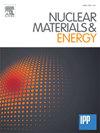ITER单块环向W/Cu/CuCrZr接头强度
IF 2.7
2区 物理与天体物理
Q1 NUCLEAR SCIENCE & TECHNOLOGY
引用次数: 0
摘要
一种新开发的ITER单块测试方法首次用于测量W/Cu/CuCrZr环向接头的强度。采用创新的锚形配置,使用iter规格的W/Cu单体来加工拉伸样品,并使用热径向压接iter规格的CuCrZr管。本文介绍了上述W/Cu/CuCrZr接头在室温和ITER运行条件下的力学测试和显微组织研究结果。研究发现,随着试验温度的不同,断裂发生在不同的位置,对应不同的损伤模式。在某些情况下,获得的极限抗拉强度可以直接与接头强度相关。然而,该方法强调了将断裂位置和断口表面的详细显微组织分析与拉伸试验结果相关联的重要性。研究结果揭示了接头强度和断裂模式与温度的相关性,并在高温下观察到破坏模式的转变。本文的结果对于解释未来中子辐照对W/Cu/CuCrZr接头的影响具有重要意义。本文章由计算机程序翻译,如有差异,请以英文原文为准。
Strength of a circumferential W/Cu/CuCrZr joint of ITER monoblock
A newly developed methodology for testing ITER monoblock was applied for the first time to measure the strength of a circumferential W/Cu/CuCrZr joint. An innovative anchor-shape configuration was used to machine tensile samples using ITER-specification W/Cu monoblocks, on which ITER-specification CuCrZr pipe was attached using hot radial pressing.
This contribution presents the results of mechanical testing and microstructural investigations of the abovementioned W/Cu/CuCrZr joints conducted at room temperature, as well as at the ITER operational conditions. It is found that depending on the test temperature, the fracture occurs in different locations corresponding to different damage modes. In some cases, the obtained ultimate tensile strength can be directly associated with the joint strength. However, the methodology emphasises the importance of correlating fracture location and detailed microstructural analysis of the fracture surface with the tensile test results. The findings reveal the dependencies of the joint strength and fracture mode on temperature, with a transition in failure modes observed at elevated temperatures. The results presented in this article are important for the interpretation of the effect of future neutron irradiation campaigns on W/Cu/CuCrZr joints.
求助全文
通过发布文献求助,成功后即可免费获取论文全文。
去求助
来源期刊

Nuclear Materials and Energy
Materials Science-Materials Science (miscellaneous)
CiteScore
3.70
自引率
15.40%
发文量
175
审稿时长
20 weeks
期刊介绍:
The open-access journal Nuclear Materials and Energy is devoted to the growing field of research for material application in the production of nuclear energy. Nuclear Materials and Energy publishes original research articles of up to 6 pages in length.
 求助内容:
求助内容: 应助结果提醒方式:
应助结果提醒方式:


